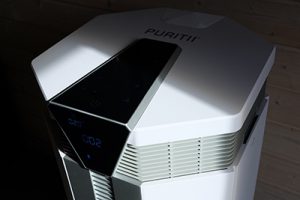(advertorial)
Cost vs. Quality in the Purchasing of Air Purifiers For UK Schools
When it comes to air purification in schools, cost has become more important than quality, yet, in the long-term, quality is the best way to reduce cost; the cost of long-term ill health, absence from education and the cost to life itself.

The plug and play Puritii Air 2.0; a more expensive option for schools that ensures >99.99% protection and beats competitors in Clean Air Delivery Rate (CADR).
The outraged discourse from heads of schools nationwide regarding the government’s recommendation to invest in ‘not the cheapest’ air purifier perhaps highlights a disconnection from the common consumer knowledge that cost usually ensures quality.
Products marketed at a price significantly lower than average means little quality assurance, potentially high costs in consumables (such as replacement filters) and low-efficacy. Where government-backed scientific research has already highlighted a key need for cleaner indoor air for children1, schools should apply due diligence when making investment choices.
For the purposes of clarity, below is an explanation of the most significant EU standards on air purifiers, specifically HEPA and MERV, and other performance factors to pay attention to when selecting the best model for the price.
HEPA Filter Grade
High-Efficiency Particulate Air (HEPA) is a standard of filtration efficiency developed in the 1940s as part of the Manhattan Project for capturing small, radioactive particles, and later commercialised in the 1950s, first as a trademarked product, but later expanded to refer to any high-efficiency filter.2
The European Union has defined several HEPA classes for air filtration, based on their retention of particulates at the Most Penetrating Particle Size (MPPS), which is usually defined as 0.12 – 0.25 microns in diameter.
True HEPA generally ranges from H10-H12. The higher the grade, the better the filter. HEPA H13-H14 are within the highest tier of HEPA and are considered medical grade quality.
Minimum Efficiency Reporting Value MERV Energy Efficiency
Minimum Efficiency Reporting Value (abbreviated as MERV) is an air filtration measurement scale developed in the 1980s by the American Society of Heating, Refrigerating, and Air-Conditioning Engineers (ASHRAE) to describe air filter effectiveness.
This scale was developed for central Heating, Ventilation, and Air-Conditioning (HVAC) systems, as the use of HEPA filtration in these systems was not practical due to the impediment of airflow caused by the dense filter material commonly used in HEPA filters.
A regular HEPA filter typically used in homes has a MERV rating between 10-12 and can only trap 85-99.50% of 0.1-micron particles. Medical-grade HEPA filters have MERV ratings of 13 and 14, which is the highest and most efficient level of filtration you can get.
Clean Air Delivery Rate CADR
The Clean Air Delivery Rate (CADR) is the cubic feet per minute (CFM) of air that has had all the particles of a given size distribution removed. As a rule of thumb, the CADR of your air cleaner should be equal to at least two-thirds of the room’s area.
Cost of Consumables
All air purifiers require replacement filters within a certain time frame. More advanced models will indicate when the filter has to be changed if it cannot be seen by the naked eye. The cost of replacing these filters, and the time interval at which this needs to happen will vary between devices. Therefore, in order to save money long-term, it’s important to select a model which is cost-effective and offers a good filter life span.

To learn more about air purification and how to select the right air purifier for your school / space, contact pippa@pure-airfiltration.com directly or visit pure-airfiltration.com.

1. iNews, 2021. ‘Air purifiers trialled in UK schools in plan to keep pupils safe from Covid-19’
https://inews.co.uk/news/air-purifiers-uk-schools-covid-1146965
2. 1. Gantz, Carroll (2012). The Vacuum Cleaner: A History. McFarland. P. 128 ISBN
9780786493210.
Please submit your comments below.
Do you have something to say about this or any other school management issue which you'd like to share? Then write for us!






